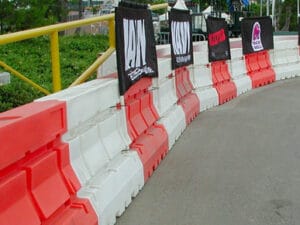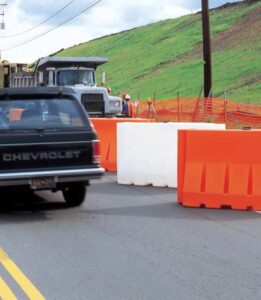 Jersey barriers have helped to increase and maintain safety on numerous roadways since the 1950s. Set up as walls which separate lanes of traffic, they are specifically designed to minimize damage and reduce the likelihood of a car crossing into oncoming lanes.
Jersey barriers have helped to increase and maintain safety on numerous roadways since the 1950s. Set up as walls which separate lanes of traffic, they are specifically designed to minimize damage and reduce the likelihood of a car crossing into oncoming lanes.
Both the nature and the uses of Jersey barriers have evolved over the years. Though they are historically (and still most commonly) concrete, Jersey Barriers are also now produced in a plastic variation. And they have moved beyond their traditional purpose of preventing auto accidents. These barriers are now also used for public safety purposes in many other situations, including construction projects, emergencies, and in defense against potential terrorism threats.
How Did Plastic Jersey Barriers Get Their Name?
Concrete barriers were used on some roadways in California in the 1940s, but the term “Jersey barrier” stuck because of the structure’s widespread introduction on the highways of New Jersey, beginning in 1955. By the end of the decade the size and shape of the barriers were refined. Engineers at the state highway department analyzed accident results to alter the barriers’ dimension to increase their effectiveness.
Why Are Concrete Jersey Barriers Used For Roadside Construction Zone?
Jersey barriers are generally 32 inches high, and two-feet wide at the bottom. Then the unit will curve to a width of approximately 6 inches at the top. At low-angle impacts, the barrier’s shape is designed to minimize sheet metal damage by allowing a vehicle’s tires to ride up the barrier’s lower slope. It’s been specifically designed to prevent a vehicle from rolling over, careening over the barrier, or being bounced back into traffic.

At higher impact angles, the vehicle’s front bumper will impact the barrier’s upper sloped face and slide upwards. When the vehicle’s wheels contact the lower sloped face, the lift reduces the friction between the tires and the paved surface; this helps to bank and redirect the vehicle.
Test results have shown that a tractor trailer, impacting a Jersey barrier at a 15 degree angle at 60 miles per hour will be successfully redirected. There are a number of variations of the Jersey barrier, some with slightly different dimensions and angles, but all adhere to the same goals and principles.
The Evolution to Plastic Jersey Barriers

Successful as Jersey barriers were, there remained a demand for a product that could provide some of the same benefits in circumstances where miles and miles of barriers were not necessary. Similarly, there was a need for a Jersey barrier-like device for short-term projects in which portability was important.
Enter the “Plastic Jersey” barrier. These barriers are made of heavy-duty, low-density polyethylene, and in use, they are water-filled. Plastic Jersey barriers offered many distinct benefits over traditional concrete barriers.
A number of small jobs or short-term projects can’t justify the cost of concrete. In these cases, the use of plastic barriers resulted in time and cost savings, because the product could be moved with relative ease, and was re-usable in a number of different circumstances. The fact that they could be used for multiple purposes (traffic, but also special events or security) often enabled entities to reduce their capital expenditures by purchasing Plastic Jersey barriers.
Plastic barriers are now frequently used not only for road work, construction zones, and water and sewer projects, but also at airports and garages (for access denial). They have also been used immediately following floods or other natural disasters and they have been used by the National Guard and the Army Corps of Engineers as a portable retaining wall.
Most commonly orange and white in color, Plastic Jersey barriers provide higher visibility to motorists, further reducing the potential for collisions. For public works entities, they offer benefits in many logistical areas. While trucks are necessary to move concrete barriers, two people can easily move plastic barriers, thus reducing transportation costs. The polyethylene material requires less maintenance than concrete and results in a longer life-span. Additionally, plastic barriers require less storage space (and its associated costs); their ability to be utilized in multiple situations or locations means they spend less time (if any) in storage.
How are Jersey Barriers Used as a Security Tool?
Because Plastic Jersey barriers are able to be quickly deployed, they have been increasingly used in emergency situations. The use of concrete barriers in emergencies has also increased in recent years. Jersey barriers provide both a physical and psychological barrier and are thus an effective tool for blocking off “no access” areas. Now universally recognized as an anti-terrorism device, Jersey barriers are frequently set up in response to car bomb threats and many other high-risk or precautionary security situations.

Conclusion
Jersey Barriers, whether concrete or plastic, have been a proven tool for highway safety for over 50 years. While concrete Jersey barriers are effective in preventing accidents and vehicle damage, the introduction of Plastic Jersey barriers provided added benefits regarding economy and portability. In addition to their use on roadways, Jersey barriers are now also used in many work and construction zones, and are increasingly used as a security and public safety tool.
